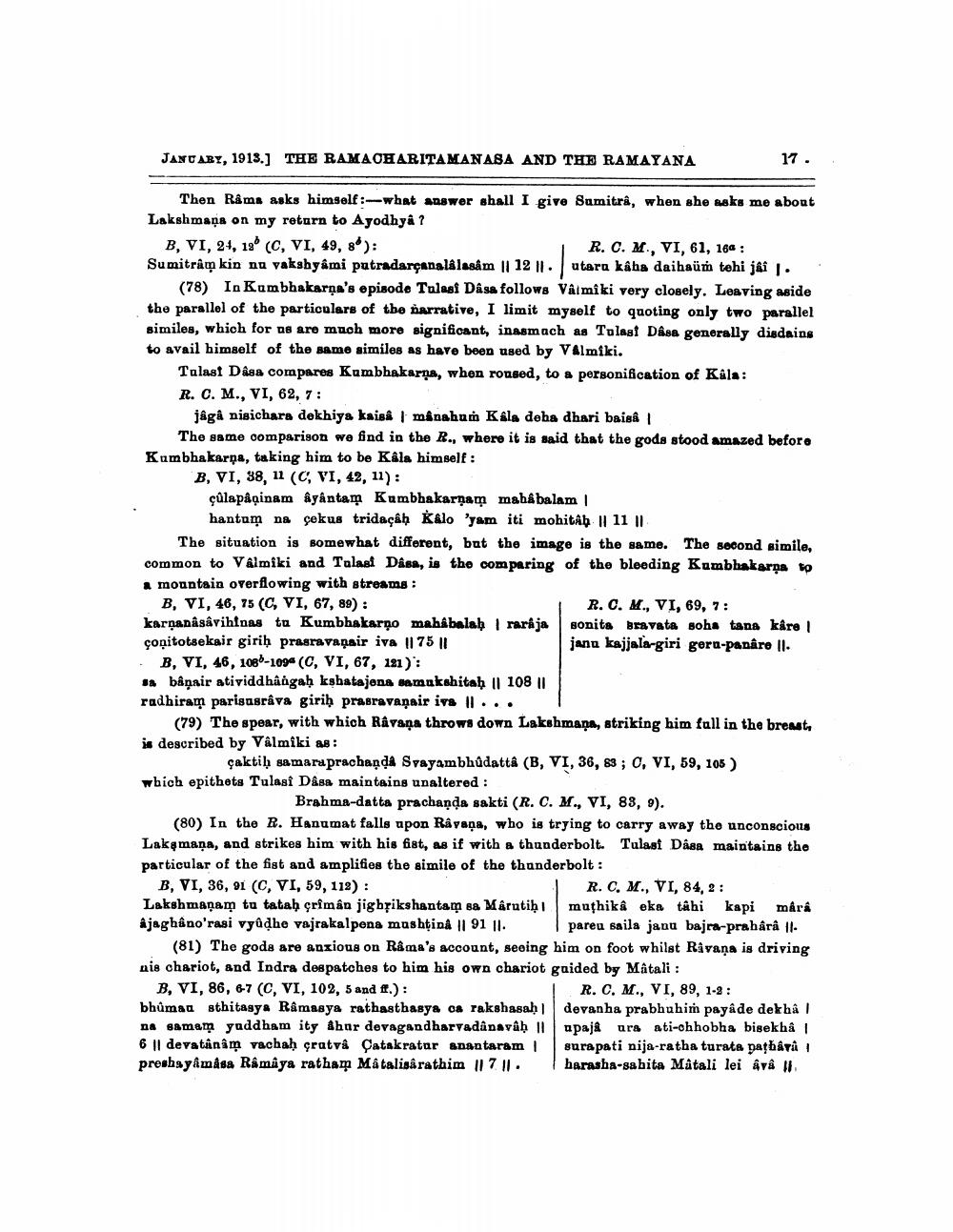________________
JANUARY, 1913.] THE RAMACHARITAMANASA AND THE RAMAYANA
Then Rama asks himself:-what answer shall I give Sumitra, when she asks me about Lakshmana on my return to Ayodhya ?
.).
B, VI, 24, 12 (C, VI, 49, 8°): R. C. M., VI, 61, 16: Sumitram kin nu vakshyami putradarçanalâlasâm || 12 ||. utara kâha daihaüm tehi jâî 1. (78) In Kumbhakarna's episode Tulasi Dâsa follows Valmiki very closely. Leaving aside the parallel of the particulars of the narrative, I limit myself to quoting only two parallel similes, which for us are much more significant, inasmuch as Tulasi Dâsa generally disdains to avail himself of the same similes as have been used by Valmiki.
Tulasi Dasa compares Kumbhakarna, when roused, to a personification of Kala:
R. C. M., VI, 62, 7:
jaga nisichara dekhiya kaisa | mânahum Kala deha dhari baisâ |
The same comparison we find in the R., where it is said that the gods stood amazed before Kumbhakarna, taking him to be Kâla himself:
B, VI, 38, 11 (C, VI, 42, 11):
çûlapâņinam âyântam Kumbhakarnam mahâbalam |
hantum na çekus tridaçâh Kalo 'yam iti mohitâb || 11 ||
The situation is somewhat different, but the image is the same. The second simile, common to Valmiki and Tulasi Dâsa, is the comparing of the bleeding Kumbhakarna to a mountain overflowing with streams:
B, VI, 46, 75 (C, VI, 67, 89):
R. C. M., VI, 69, 7: karganâsâvihinas tu Kumbhakarno mahâbalah raraja sonita Bravata soha tana kâre | çonitotsekair giriḥ prasravanair iva || 75 || janu kajjala-giri geru-panâre II.
B, VI, 46, 108-109 (C, VI, 67, 121):
sa bâņair atividdhângaḥ kshatajena samukshitaḥ || 108 || radhiram parisusrâva giriḥ prasravanair iva || ...
17.
(79) The spear, with which Ravana throws down Lakshmana, striking him full in the breast, is described by Valmiki as:
çaktiḥ samaraprachanda Svayambhûdattâ (B, VI, 36, 83; C, VI, 59, 105) which epithets Tulasi Dâsa maintains unaltered:
Brahma-datta prachanda sakti (R. C. M., VI, 83, 9).
(80) In the R. Hanumat falls upon Râvana, who is trying to carry away the unconscious Lakamana, and strikes him with his fist, as if with a thunderbolt. Tulasi Dâsa maintains the particular of the fist and amplifies the simile of the thunderbolt:
B, VI, 36, 91 (C, VI, 59, 112):
Lakshmaṇam tu tataḥ çrîmân jighṛikshantam sa Marutiḥ ajaghano'rasi vyûdhe vajrakalpena mushținâ || 91 ||
(81) The gods are anxious on Râma's account, seeing nis chariot, and Indra despatches to him his own chariot B, VI, 86, 6-7 (C, VI, 102, 5 and ff.):
bhuman sthitasya Râmasya rathasthasya ca rakshasaḥ na samam yuddham ity âhur devagandharvadânavâḥ I 6 || devatânâm vachah çratva Çatakratur anantaram | preshayâmâsa Râmâya ratham Mâtalisârathim || 7 ||.
R. C. M., VI, 84, 2:
muthika eka tâhi kapi mârâ pareu saila janu bajra-prahârâ ||him on foot whilst Ravana is driving guided by Mâtali:
R. C. M., VI, 89, 1-2: devanha prabhuhim payâde dekha | upajâ ura ati-chhobha bisekha | surapati nija-ratha turata pathâvû | harasha-sahita Mâtali lei ava II.




